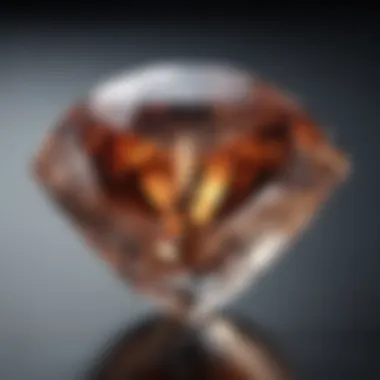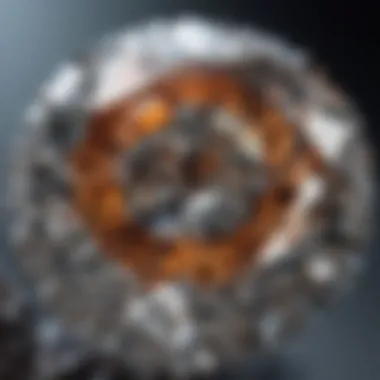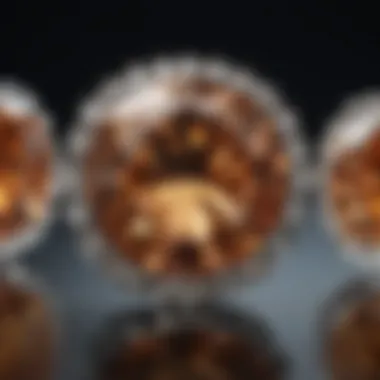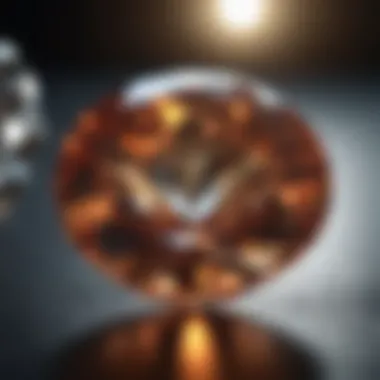Understanding the Brilliant Cut: A Deep Dive


Intro
The exploration of diamonds, especially the brilliant cut, invites both fascination and intrigue. Diamonds have long been symbols of status and elegance. The brilliant cut, in particular, is a masterpiece of craftsmanship designed for light performance, beauty and value.
Gemstone Overview
Definition and Characteristics
A diamond is a crystalline form of carbon, renowned for its hardness and brilliance. The brilliant cut is defined by its intricate arrangement of facets which maximize the gem's light performance. Typically, these diamonds have 58 facets. This cutting style enhances the reflection and refraction of light, creating the sparkle that captures attention in various lighting conditions.
Classification of Gemstones
Gemstones can be classified in several ways—by their chemical composition, crystal structure, and visual effects. However, the classification that often interests consumers is based on beauty and rarity. Diamonds, especially those with brilliant cuts, stand out in terms of luster and radiance. Their status as precious stones is not just due to their beauty but also their durability and historical prominence.
Historical Significance
Ancient Uses and Cultural Importance
Diamonds have been cherished for centuries, with their history tracing back to ancient India where they were used as religious icons and adornments for royalty. The brilliance of the diamond often represented the status of the wearer. Over time, they became associated with commitments and love, cementing their place in engagement rings.
Myths and Legends Surrounding Gemstones
Throughout history, diamonds have been intertwined with myths and legends. Some cultures believed they held protective powers against evil spirits, while others thought they could bring fortune and success to their owners. These beliefs fueled demand, contributing to the gemstone’s legacy and ongoing allure in modern society.
"Diamonds are forever, representing not only wealth but eternal moments in life."
By analyzing these aspects, the significance of brilliant cut diamonds in culture, art, and economics becomes apparent. For enthusiasts and investors alike, understanding this dimension enhances appreciation and informs purchasing decisions.
Prelims to Diamonds and Their Cuts
Diamonds are not just the hardest natural substance known, they are also the most iconic gemstones, symbolizing wealth, commitment, and affection. The cut of a diamond significantly influences both its aesthetics and value. This section introduces the importance of understanding diamond cuts, particularly the brilliant cut, which has captivated jewelry enthusiasts and investors for centuries. In uncovering the various forms diamonds can take when shaped by skilled artisans, one gains deeper insight into their inherent beauty, light performance, and market desirability.
Overview of Diamond Cuts
Every diamond begins as a rough stone harvested from the earth, but its ultimate value is largely determined by its cut. There are numerous different styles of diamond cuts, including the princess cut, emerald cut, and, most notably, the brilliant cut. Each style carries unique characteristics and visual appeal. The brilliant cut, with its multifaceted design, is crafted to maximize light reflection and refraction, creating an unparalleled sparkle. This section will discuss those various cuts and how they influence the overall perception of diamonds in both jewelry and investment markets.
Importance of Cut Quality
The quality of a diamond cut plays a crucial role in defining not only the beauty of the stone but also its market price. A well-cut diamond will reflect light more effectively, leading to greater brilliance and scintillation. Buyers often overlook this aspect, focusing instead on carat weight or color. However, understanding the quality of the cut is essential for making informed purchasing decisions. Factors such as the proportion, symmetry, and finish all contribute to the overall quality. Excellent cut quality enhances the diamond's visual impact and ultimately influences its enduring value within the marketplace.
"The cut is the single most important determinant of a diamond's beauty and brilliance." - GIA
In summary, this section sets the foundation for a detailed exploration of what the brilliant cut means for diamonds. The following sections will delve more into the technical aspects, light performance, and market trends that support the appeal of this particular cut.
The Brilliant Cut Explained
The brilliant cut is a hallmark of diamond craftsmanship, often associated with elegance and sparkle. This section aims to elaborate on its definition, characteristics, and historical backdrop to emphasize its significance within the realm of gemstones. Exploring the brilliant cut is essential not only for enthusiasts but also for anyone interested in the gemstone market. A well-executed brilliant cut can elevate the aesthetic appeal of a diamond, making it a preferred choice among consumers.


Definition and Characteristics
The brilliant cut is defined by its intricate arrangement of facets, designed to optimize the diamond's ability to refract light. Typically, a standard brilliant cut diamond features a round shape, comprising 58 facets, strategically crafted to enhance light performance. Each facet interacts with light, producing a captivating display of brilliance, fire, and scintillation.
- Brilliance refers to the brightness emitted from the diamond. It is the result of the white light that enters and reflects back through the facets.
- Fire pertains to the dispersion of light into a spectrum of colors. A well-cut diamond exhibits a rainbow effect that captivates the observer.
- Scintillation describes the sparkle that occurs as the diamond moves, creating dancing lights across its surface.
Understanding these fundamental characteristics is crucial for consumers, as they significantly impact the perceived value and beauty of the diamond. The cut quality plays an integral role in determining these attributes. It involves precise angles and proportions to achieve the best light performance, ensuring that the diamond sparkles brilliantly.
Historical Development of the Brilliant Cut
The origin of the brilliant cut can be traced back to the late 17th century, evolving through various styles before reaching its contemporary form. Initially, diamonds were cut in simple shapes, such as the table cut and the rose cut. However, the need for a cut that maximized light performance led to experimentation.
The development of the brilliant cut is largely credited to the innovative work of jeweler Marcel Tolkowsky in 1919. He introduced a mathematical approach to diamond cutting, emphasizing the importance of proportions. His guidance on the angles and depth of the diamond became foundational, effectively setting the standard for all brilliant cut diamonds today.
Over the decades, technology has further refined the processes involved in cutting and shaping diamonds. Modern methods now include laser cutting, which enhances precision and allows for more intricate designs. As the brilliant cut continues to evolve, its historical significance remains a testament to the artistry and science behind crafting a diamond that embodies both beauty and luminosity.
Technical Aspects of Brilliant Cut Diamonds
The technical aspects of brilliant cut diamonds are fundamental to understanding their appeal and performance. These elements define not only the aesthetic qualities of the diamond, but also its functional characteristics when it comes to refracting and reflecting light. The brilliant cut is designed to maximize brightness and scintillation, two critical factors in a diamond's visual impact. Therefore, each technical component plays a significant role in achieving this goal, making it essential for buyers and enthusiasts to comprehend how these attributes contribute to the overall quality and value of a brilliant cut diamond.
Faceting and Geometry
The faceting and geometry of a brilliant cut diamond are pivotal to its ability to harness light effectively. A well-executed faceting arrangement enhances the diamond's brilliance. Each facet serves to reflect, refract, and disperse light, creating the stunning visual effects that diamonds are known for.
The geometry involves the relationships between the diamond's various parts, including the crown, pavilion, and table. These elements work together in harmony. If any part is misaligned or poorly shaped, it can diminish the diamond's overall appearance.
Proportions and Performance
The proportions of a diamond, specifically regarding its depth, crown, and pavilion angles, are critical to its performance.
Depth Percentage
Depth percentage refers to the ratio of the diamond's total depth measured from the table to the culet to the diamond's diameter. This characteristic directly impacts the light performance of the diamond.
A well-balanced depth percentage typically ranges from 43% to 62%. This balance allows for optimal light reflection and enhances brilliance. If the percentage is too high or too low, light escapes rather than reflecting, leading to a dull appearance. Thus, maintaining the right depth percentage is advantageous for a buyer looking for maximum brilliance.
Crown Angle
The crown angle denotes the angle of the facets on the crown of the diamond. Generally, a crown angle of between 34° and 35° is ideal for achieving the most brilliance. This angle is crucial because it affects how light enters the diamond and how well it reflects back to the observer. A well-defined crown angle fosters a stunning balance of brilliance and fire. Though, if the angle is too flat, it can cause light to escape, resulting in less light return.
Pavilion Angle
The pavilion angle refers to the facets of the lower portion of the diamond. Ideally, the pavilion angle should be between 40.6° and 41.2°. This angle impacts how light travels within the diamond after entering through the crown. An appropriate pavilion angle enhances the return of light to the observer. Anything outside this range risks light leakage. Thus, optimizing the pavilion angle is also crucial to maintaining a diamond's beauty and value.
Understanding the intricate details of a diamond's technical aspects not only helps in appreciating its beauty but also guides consumers towards sound investment choices.
Light Performance in Brilliant Diamonds
Light performance is a crucial aspect of brilliant cut diamonds. It greatly influences the diamond's overall appeal and desirability. When buyers consider a diamond's value, they often focus on how it interacts with light. A well-crafted brilliant cut maximizes light return and enhances the gem's beauty. Understanding light performance involves examining its key attributes deeply.


Understanding Brilliance, Fire, and Scintillation
Brilliance, fire, and scintillation are the three principal elements that define the light performance of brilliant cut diamonds.
- Brilliance refers to the amount of white light that the diamond reflects. It is the result of good proportions, symmetry, and an effective cut. High brilliance means more light is returned to the viewer’s eye.
- Fire is the dispersion of light into various colors. A diamond with pronounced fire presents a spectrum of hues, adding to its visual appeal. The quality of the cut influences fire significantly.
- Scintillation describes the sparkle of a diamond when it moves or is viewed under changing light conditions. A diamond that exhibits scintillation has well-placed facets, which create a play of light and shadow.
Each of these characteristics contributes uniquely to the overall beauty of a brilliant cut diamond. When these elements are well-balanced, they create a mesmerizing effect, captivating anyone who gazes upon the stone.
Measuring Light Performance
Accurate measurement of light performance in brilliant cut diamonds is essential for assessing their quality. Several methods exist to evaluate this performance, using both modern technology and traditional principles.
- BrillianceScope: This instrument measures the percentage of light reflected from the diamond and provides a score that indicates brilliance.
- Ideal Scope: This simple tool accomplishes a visual assessment of light return. It allows observers to see which areas of the diamond reflect light well and which do not.
- Light Performance Grading: Many grading labs issue reports that detail the light performance of diamonds, offering insights regarding brilliance, fire, and scintillation.
"A diamond that highlights these aspects of light performance is more valuable and sought after."
Engaging with these measurements allows both buyers and sellers to make informed decisions. Awareness of light performance fosters better appreciation for the brilliance cut diamonds, guiding enthusiasts toward selections that align with their preferences.
Brilliant Cut vs Other Cuts
The topic of Brilliant Cut vs Other Cuts is key to understanding not only the brilliant cut itself but also how it positions itself within the wider landscape of diamond cuts. This section brings forth various aspects to consider when comparing the brilliant cut to other popular cuts like the princess and emerald cuts. Each cut has distinct characteristics and appeal, contributing to its unique place in the market. The brilliant cut stands out primarily due to its ability to maximize light performance, which many buyers find attractive. However, consumer preferences often vary based on individual tastes and trends in the jewelry industry.
Comparison with Princess and Emerald Cuts
The brilliant cut is renowned for its ability to produce exceptional brilliance—the bright sparkle perceived when looking at the diamond. In comparison, the princess cut also offers considerable light performance, yet it tends to emphasize a different aesthetic. The princess cut is characterized by its square shape and sharp corners, providing a modern look that appeals to a younger demographic. While both cuts can exhibit high brilliance, the princess cut's visual impact is often closely associated with its unique silhouette, which some consumers may prefer.
On the other hand, the emerald cut presents an entirely different appeal. With its rectangular shape and step-cut faceting, the emerald cut is designed for clarity rather than brilliance. It features long, flat facets that draw the eye towards the stone's depth and clarity, rather than reflecting light. The aesthetic appeal of the emerald cut resonates with those who appreciate a vintage or sophisticated look. Here’s a quick comparison:
- Brilliant Cut: Maximum brilliance, round shape, multiple facets.
- Princess Cut: Square shape, modern design, good brilliance but less than the brilliant cut.
- Emerald Cut: Rectangular shape, clarity-focused, vintage appeal.
Each cut has its strengths and appeals to different buyer preferences and styles. Understanding these differences is essential for anyone considering purchasing a diamond.
Consumer Preferences and Trends
The preferences of consumers in the diamond market are fluid and influenced by various factors. In recent years, the brilliant cut has regained popularity among consumers who prioritize light performance and dazzling appearance. However, preferences can shift based on cultural influences, fashion trends, and marketing.
Market trends indicate a growing appreciation for unique cuts. Some consumers look for distinguishing features like non-traditional shapes or cuts that tell a story. As more people become educated on diamonds, there is a move towards personal expression in jewelry selection. Buyers today often seek engagement rings or statement pieces that reflect their individual style rather than conforming to traditional expectations.
Moreover, many buyers are increasingly considering ethical and sustainable sourcing in their purchasing decisions. This factor plays a crucial role in shaping market trends, as consumers become more discerning about the origins of their gems.
In summary, the comparison between the brilliant cut and other cuts like princess and emerald is essential for understanding current market dynamics. Awareness of consumer preferences offers valuable insights into the future of diamond selection.
Market Trends in Brilliant Cut Diamonds
Market trends in brilliant cut diamonds reflect not only consumer preferences but also the broader economic environment. Understanding these trends is essential for enthusiasts, potential buyers, and investors. The value and desirability of brilliant cut diamonds fluctuate for various reasons, including changes in fashion, advancements in technology, and shifting cultural attitudes towards luxury goods.
The importance of recognizing these trends cannot be overstated. An informed consumer is better positioned to make strategic purchasing decisions. Additionally, trends influence the production and marketing strategies of jewelers and diamond merchants. Following market trends can provide insight into future investment opportunities as well.
Investment Value of Brilliant Cut Diamonds


Brilliant cut diamonds have long been valued as both aesthetic luxuries and financial assets. Their investment value is rooted in several key elements:
- Rarity and Quality: Well-cut brilliant diamonds, especially those with excellent clarity and color, maintain their value over time. Investors often prioritize these characteristics when selecting stones.
- Market Demand: The continued popularity of brilliant cut diamonds ensures a steady demand in both retail and secondary markets. This demand can lead to price appreciation sustained over years.
- Historical Performance: Historical data indicate that diamonds, particularly fine-quality brilliant cuts, can yield substantial ROI compared to other forms of investment.
"Investing in brilliant cut diamonds is not just about acquiring a beautiful object; it is about ensuring a potential return on investment through careful selection and market timing."
Investors should also consider the effects of economic shifts and market conditions. Economic downturns may cause temporary declines in demand; however, quality diamonds often rebound well.
Emerging Market Preferences
The landscape of diamond purchasing is evolving, especially with emerging markets making their mark. Countries like India and China are experiencing growing middle classes that prioritize luxury goods. Here are some notable emerging market preferences:
- Customization: Buyers are increasingly seeking customized settings for their diamonds. Personalized jewelry adds a unique touch that appeals to individual tastes and preferences.
- Sustainable Sourcing: Ethical sourcing is becoming a priority. Consumers tend to favor diamonds that come with certifications of ethical mining practices.
- E-commerce Growth: The shift to online shopping has reshaped how diamonds, particularly brilliant cut ones, are marketed and sold. Online platforms provide access to a broader audience and foster competition among sellers.
These trends indicate a shift in how diamonds are perceived and purchased. An understanding of these evolving preferences can enhance opportunities for sellers and guide buyers in making informed decisions.
Care and Maintenance of Brilliant Cut Diamonds
The care and maintenance of brilliant cut diamonds is essential for preserving their aesthetic appeal and ensuring their longevity. These diamonds are renowned for their brilliance and sparkle, which stems from their intricate cut and precise proportions. However, without proper care, these diamonds can accumulate dirt and scratches, diminishing their beauty.
Regular cleaning and appropriate storage play crucial roles in maintaining the brilliance of these gemstones. Regular maintenance ensures that the diamond's light performance remains optimal, avoiding the dullness that can occur over time. Moreover, professional services provide additional assurance that your diamond remains in pristine condition, offering expertise that goes beyond simple cleaning at home.
Cleaning and Storage Recommendations
Cleaning is necessary to keep the brilliant cut diamond shining. Home cleaning methods can be effective if done correctly. Here are some recommendations for maintaining your diamond's clarity:
- Use a soft brush: A gentle, non-abrasive brush can help remove dirt from the crevices of your diamond. Make sure it is a soft-bristled brush to avoid scratching the metal or the diamond itself.
- Mild soap solution: Mix warm water with mild dish soap. Soak the diamond briefly in this solution, then gently scrub it with the soft brush. Rinse it thoroughly under running water to remove any soap residue.
- Avoid harsh chemicals: Never use bleach or abrasive cleaners. These can damage the setting or the diamond.
- Drying: Use a clean, soft cloth to dry the diamond. Avoid paper towels, as they can be abrasive.
When it comes to storage, consider the following points:
- Separate compartments: Store your diamond jewelry in separate compartments or soft bags to prevent scratching against other jewelry.
- Avoid extreme temperatures: Extreme heat can affect the diamond's setting. Always store your jewelry in a stable environment.
- Jewelry box: Invest in a quality jewelry box lined with soft fabric, which can protect your pieces from dust and scratches.
Professional Maintenance Services
While at-home care is vital, professional maintenance services are also important. Experts can offer services that attendees might not be able to perform themselves. Here are several key services that professionals provide:
- Thorough cleaning: Jewelers utilize ultrasonic cleaners that can remove grime and debris that at-home methods cannot reach.
- Inspection: A professional can check for loose settings or damage. They can also ensure that the diamond remains secure in its setting, providing peace of mind.
- Polishing: Over time, diamonds may accumulate micro-scratches. Professionals can polish the diamond to restore its luster without damaging it.
- Re-evaluation: If you bought your diamond from a reputable jeweler, they may offer services to reassess the diamond's health over the years, ensuring it remains a prized possession.
Investing time and resources in the care and maintenance of brilliant cut diamonds ensures their beauty endures well beyond initial purchase, validating their place as cherished items for generations.
Ending: The Enduring Allure of Brilliant Cut Diamonds
The brilliant cut diamond holds a unique position in the gemstone market. Its design not only enhances the aesthetic appeal but also optimizes light performance. Such diamonds often become a focal point in jewelry, bringing an undeniable charm. The characteristics that define a brilliant cut contribute to its lasting popularity.
One crucial element is the cut's ability to reflect light in a way that compels admiration. Brilliance, fire, and scintillation—these three aspects set brilliant cut diamonds apart. They create a visual spectacle that captivates onlookers. When evaluating a diamond, consumers must consider how well these factors are exhibited.
In terms of market value, brilliant cut diamonds show resilience even in fluctuating economic conditions. Their timeless appeal ensures a steady demand among collectors and investors. Buyers often recognize brilliant cut diamonds not only for their beauty but as a wise financial investment. In a world where tastes may shift, the core attributes of brilliance remain unchanged.
When thinking about purchasing a diamond, understanding the nuances of cuts, especially brilliant cuts, is vital. It is essential to grasp how proportions and ratings affect overall quality.
The intricate relationship between light and the cut makes the diamond far more than just a piece of jewelry; it becomes a statement of elegance and prestige.
Additionally, the emotional value attached to diamonds is profound. They often symbolize important milestones in life, reinforcing their desirability. The brilliant cut, because of its radiant properties, is typically the first choice for engagement rings. Couples see it as a sign of commitment, further embedding its status in societal traditions.
The enduring allure of brilliant cut diamonds is, therefore, multifaceted. Their rich history, sophisticated design, and emotional significance ensure they will remain desirable for decades to come. As consumer preferences evolve, the brilliance retained in each of these diamonds positions them as timeless treasures.







